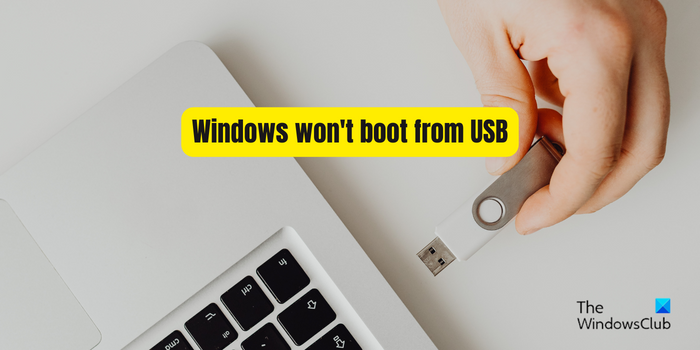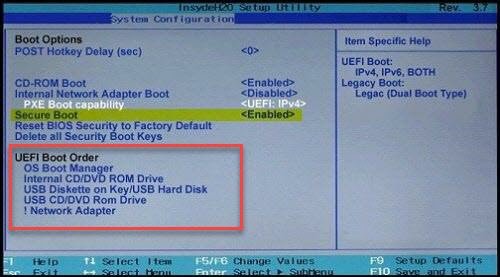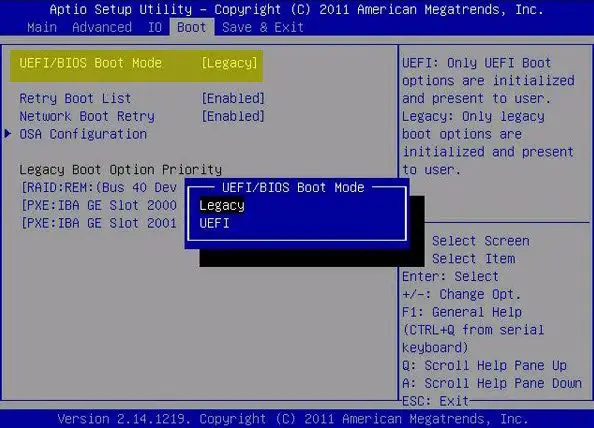Can’t boot Windows using a USB drive? If yes, you have come to the correct page. In this post, we will help you find a working fix for boot issues with USB.

How do I force Windows to boot from USB?
To boot Windows using USB, you first need to create a bootable USB drive. Once done, access your PC’s BIOS settings and set the Boot order to the USB device. After that, plug in your bootable USB, restart your PC, access the Advanced startup options, select the Use a device option, and then choose your USB drive to start the boot process.
However, many users have complained that they can’t boot Windows using a bootable USB/flash drive. Let us find out why this issue may occur.
Why is Windows not booting from USB?
There can be different Windows is not booting from a USB drive. It can be because your USB drive is damaged or wrongly formatted. Apart from that, your PC not supporting USB boot can be another factor responsible for this issue. Your BIOS settings like boot order can also cause this issue.
Fix Windows won’t boot from USB
If you are unable to boot Windows using a bootable USB drive on your system, follow the below solutions to fix the issue:
- Ensure that your USB drive is bootable and formatted correctly.
- Make sure your PC supports USB boot.
- Set the Boot Priority to USB drive in BIOS/UEFI.
- Enable CSM/Legacy Boot, and disable Secure Boot.
- Create a new bootable USB using the Windows Media Creation Tool or third-party software like Rufus.
1] Ensure that your USB drive is bootable and formatted correctly
The first thing you should check is whether, in actuality, your USB drive is bootable or not. It might be the case that your bootable USB drive is corrupted or created in a wrong way which is why you can’t boot Windows from USB.
You can use different ways to check if your USB drive is bootable or not. For example, there is a free software called MobaLiveCD that allows you to run a bootable USB drive check on your computer.
Apart from being bootable, check the file system of your USB drive as per your computer’s configurations. If your computer’s boot mode is UEFI, your USB must be formatted in the FAT32 file system. So, format your bootable USB drive to FAT32 and see if the issue is resolved.
Read: How to Boot from USB Drive within Windows?
2] Make sure your PC supports USB boot
Before booting from USB, make sure your computer supports USB boot. To check that, you need to access your PC’s BIOS/UEFI settings. Just restart your PC and press the F1 F2, F10, or Esc key (depending on your computer’s manufacturer) during the startup process to enter your BIOS settings. Now, move to Boot Options and look for an option with “USB,” “USB Device,” or likewise. If there is an option like that, you can be sure that your PC supports USB boot.
3] Set the Boot Priority to USB drive in BIOS/UEFI

The next thing you can do to fix this issue is change your boot order in your BIOS settings. Your PC might be set to boot from the internal hard disk. Thus, you are unable to boot from USB. So, see the boot priority to the USB drive to fix the issue. Here are the steps to do that:
- First, restart your computer and access the BIOS settings by pressing the assigned key like F2 during the startup process.
- Now, find the Boot Options and change the first boot drive to USB.
- Next, click on the Save & exit button and see if the issue is resolved.
See: Fix Windows Startup and Boot problems Advanced Troubleshooting.
4] Enable CSM/Legacy Boot, and disable Secure Boot

You can also try making some of your BIOS settings and then see if it helps you boot Windows from a USB drive. Disable Secure Boot and enable Legacy Boot to check if it helps. Here’s how to do that:
- First, connect your bootable USB drive to your PC, start your PC, and access your BIOS settings.
- Now, go to the Security > Secure Boot Control option and disable it.
- Next, move to the Boot > Launch CSM option and enable it.
- Also, set the UEFI/BIOS Boot Mode to Legacy.
- After that, save the new settings and start your PC to check if the problem is resolved.
5] Create a new bootable USB using the Windows Media Creation Tool or third-party software like Rufus
If the problem remains the same, you can recreate a new bootable USB drive. You can do that using Windows Media Creation Tool or a third-party application like Rufus. Many other free tools let you create a bootable USB drive like Passcape ISO Burner, ISO to USB, WinToUSB, and SARDU MultiBoot Creator.
I hope this helps!
Now read: Best free Boot Repair Tools for Windows.
Leave a Reply